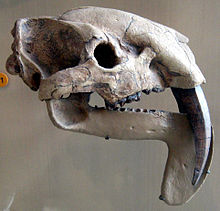Thylacosmilus
| Thylacosmilus | |
|---|---|

| |
| Thylacosmilus atrox Field Museum of Natural History | |
| Scientific classification | |
| Kingdom: | |
| Phylum: | |
| Class: | |
| Infraclass: | |
| Order: | |
| Family: | Thylacosmilidae
|
| Genus: | Thylacosmilus Riggs, 1933
|
Thylacosmilus is a extinct genus of carnivorous sparassodont.[1] found as fossils in deposits dated from about 10 million to 3 million years ago (late Miocene to late Pliocene epoch) in Argentina, South America.
Thylacosmilus was sabre-toothed and was about as large as a modern jaguar. To a remarkable degree, Thylacosmilus paralleled the evolution of felid sabre-toothed cats like Smilodon. Its canine teeth were long and powerfully developed; they were used for stabbing prey. Its killing method was to hold its prey, and make deep bites into the soft tissue driven by powerful neck muscles.[2][3] The canine teeth were protected by a well-developed flange, or projecting edge, in the chin region of the lower jaw. The canines continued to grow during adult life, which they do not in marsupials or placental mammals.[4]
Thylacosmilus died out during the late Pliocene, whereas saber-toothed cats did not get to South America until the middle Pleistocene epoch.[5][6] As a result, the last appearance of Thylacosmilus is separated from the first appearance of Smilodon by over one and a half million years.
References
[change | change source]- ↑ The Sparassodonta were actually not marsupials, but a sister group which used to be described as marsupials.
- ↑ Hogenboom, M. (2013). "Sabretooth killing power depended on thick neck". BBC. Retrieved 2013-08-03.
- ↑ Wroe, S.; et al. (2013). "Comparative biomechanical modeling of metatherian and placental saber-tooths: a different kind of bite for an extreme pouched predator". PLOS ONE. 8 (6): e66888. doi:10.1371/journal.pone.0066888. PMC 3694156. PMID 23840547.
- ↑ Sparassodonts did not have the regular two-stage growth pattern of modern mammals.
- ↑ see Great American Interchange.
- ↑ Prevosti, Francisco J; Forasiepi, Analia & Zimicz, Natalia 2013. The evolution of the Cenozoic terrestrial mammalian predator guild in South America: competition or replacement?. Journal of Mammalian Evolution 20: 3–21. [1]
